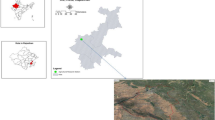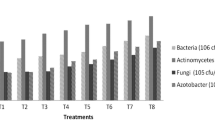Abstract
An investigation was carried out by conducting a field experiment at the farm of the Mahatma Phule Krishi Vidyapeeth (MPKV), Rahuri. The significant grain yield of soybean (37.5 q ha−1) and maize (49 q ha−1) were observed in the treatment receiving 100 % recommended doses of Nitrogen, Phosphorus and Potassium (NPK) + in situ compost of crop residues, pressmud compost (T6). After harvest of maize dehydrogenase activity, acid phosphatase, β-glucosidase and urease were significantly improved in T7 treatment as compared to other treatments. However, fluorescein diacetate activity and alkaline phosphatase were significantly greater in T6 treatment in post-harvest soil samples of maize. In the post-harvest soil of maize the bacterial and actinomycetes population were greater in the treatment receiving in situ decomposition of sugarcane crop residues + 100 % recommended dose of NPK (T3). The fungal population after harvest of maize was found maximum in treatment T7. The total organic carbon was significantly correlated with dehydrogenase (r = 0.65, P < 0.01), fluorescein diacetate (r = 0.71, P < 0.01), acid phosphatase (r = 0.66, P < 0.01), β-glucosidase (r = 0.65, P < 0.01), and urease (r = 0.57, P < 0.01). There was a significant correlation (r = 0.77, P < 0.01) between TOC and soybean yield, and between total organic carbon and maize yield (r = 0.98, P < 0.01). The result suggest that in situ recycling of sugarcane crop residues and the industrial wastes with suitable interventions like use of bioinoculum, phosphatic fertilizer and urea may help for improving better crop productivity and soil biological activities.



Similar content being viewed by others
References
Pandurangegowda KT (2012) Farmers urged not to burn sugarcane trash. The Hindu. 27 May, 2012
Phalke DH, Patil SR, Manna MC, Pharande AL, Durgude AG, Solanke AV, Nimbalkar CV, Kolekar PT (2014) In situ recycling techniques of sugarcane crop residues and industrial wastes for better productivity and soil health. Technology bulletin, Mahatma Phule Krishi Vidyapeeth, Rahuri, pp 1–22
Manna MC, Swarup A, Wanjari RH, Ravankar HN, Mishra B, Saha MN, Singh YV, Sahi DK, Sarap PA (2005) Long-term effect of fertilizer and manure application on soil organic carbon storage, soil quality and yield sustainability under sub-humid and semiarid-tropical India. Field Crops Res 93:264–280
Manna MC, Jha Praomad, Lakaria Brijlal, Subba Rao A (2013) Soil organic matter under different agro-climatic regions of India. Scientific bulletin IISS, Bhopal
Sinsabaugh RL, Antibus RK, Linkins AE (1991) An enzymic approach to the analysis of microbial activity during plant litter decomposition. Agric Ecosyst Environ 34:43–54
Dick RP, Breakwill D, Turco R (1996) Soil enzyme activities and biodiversity measurements as integrating biological indicators. In: Doran JW, Jones AJ (eds) Handbook of Methods for Assessment of Soil Quality. Soil Science Society America, Madison, pp 247–272
Nannipieri P (1994) The potential use of soil enzymes as indicators of productivity sustainability and pollution. In: Pankhurst CE, Doube BM, Gupta VVSR, Grace PR (eds) Soil biota. Management in sustainable fanning systems CSIRO, Melbourne, pp 238–244
Goyal S, Chander K, Kapoor KK (1995) Effect of distillery wastewater application on soil microbiological properties and plant growth. Environ Ecol 13:89–93
Mandal A, Patra AK, Singh D, Swarup A, Masto RE (2007) Effect of long term application of manure and fertilizer on biological activities in soil during crop development stages. Bioresour Technol 98:3585–3592
Tabatabai MA, Bremner JM (1972) Assay of urease activity in soil. Soil Biol Biochem 4:479–487
Tabatabai MA, Bremner JM (1969) Use of nitrophenyl phosphate for assay of phosphatase activity. Soil Biol Biochem 1:301–307
Eivazi F, Tabatabai MA (1988) Glucosidases and galactosidases in soils. Soil Biol Biochem 20:601–606
Casida LE, Klein D, Santora T (1964) Soil dehydrogenase activity. Soil Sci 98:371–378
Schnurer J, Roswall T (1982) Fluorescein diacetate hydrolysis as a measure of total microbial activity in soil and litter. Appl Environ Microbiol 43:1256–1261
Chhonkar PK, Bhadvaray S, Patra AK, Purukayastha TT (2007) Soil enzymes in experiments in soil biology and biochemistry. Westvile Publishing House, New Delhi, pp 1–182
Walkley A, Black CA (1934) An examination of the Degtjareff method for determining soil organic matter and a proposed modification of the chromic acid titration method. Soil Sci 37:29–38
Panse VG, Sukhatme PV (1985) Statistical Methods for agricultural workers. ICAR, New Delhi
Dick WA, Tabatabai MA (1984) Kinetic parameters of phosphatase in soils and organic waste materials. Soil Sci 137:7–15
Martens DA, Johanson JB, Frankenberger WT (1992) Production and persistence of soil enzymes with repeated additions of organic residues. Soil Sci 153:53–61
Bhattacharyya P, Roy KS, Neogi S, Adhya TK, Rao KS, Manna MC (2012) Effects of rice straw and nitrogen fertilization on greenhouse gas emissions and carbon storage in tropical flooded soil planted with rice. Soil Tillage Res 124:119–130
Rao DLN, Pathak H (1996) Ameliorative influence of organic matter on biological activity of salt affected soils. Arid Soil Res Rehabil 10:311–319
Batra L, Manna MC (1997) Dehydrogenase activity and microbial biomass carbon in salt-affected soils of semi-arid and arid regions. Arid Soil Res Rehabil 11:295–303
Graham MH, Haynes RJ (2005) Organic matter accumulation and fertilizer-induced acidification interact to affect soil microbial and enzyme activity on a long-term sugarcane management experiment. Biol Fertil Soils 41:249–256
Mathew T, Varughese K (2007) Effect of various nutrients on physico-chemical and biological properties of soils in sugarcane agro-ecosystem. Sugar Tech 9(2 & 3):147–151
Rajannan G, Oblisami G (1979) Effect of paper factory effluents on soil and crop plants. Indian J Environ Health 21:120–130
Lee JJ, Park RD, Kirn YW, Shim JH, Chae DH (2004) Effect of foode waste compost on microbial population, soil enzyme activity and growth. Bioresour Technol 93:21–28
Valliappan K (1998) Recycling of distillery spentwash: An ecofriendly effective reclamation technology for sodic soils. Ph.D. Thesis, Tamil Nadu Agricultural University, Coimbatore
Chang EH, Chung RS, Tsai YH (2007) Effect of different application rates of organic fertilizer on soil enzyme activity and microbial population. Soil Sci Plant Nutr 53:132–140
Acknowledgments
The authors are grateful to Dr. A. Subba Rao, Director, Indian Institute of Soil Science, Bhopal, India for providing laboratory facility for analysis of soil organic carbon fractionations and also thank him for critical review of the manuscript. The technical assistance of Mr. V. B. Pal, Mr. V. Chaudhary, Mr. Bhoilal Uikey and Mr. Ram Bharose is duly acknowledged.
Author information
Authors and Affiliations
Corresponding author
Rights and permissions
About this article
Cite this article
Phalke, D.H., Patil, S.R., Pharande, A.L. et al. Effect of In situ Recycling of Sugarcane Crop Residues on Soil Enzyme Activities Under Soybean–Maize System. Proc. Natl. Acad. Sci., India, Sect. B Biol. Sci. 86, 299–307 (2016). https://doi.org/10.1007/s40011-014-0433-5
Received:
Revised:
Accepted:
Published:
Issue Date:
DOI: https://doi.org/10.1007/s40011-014-0433-5




